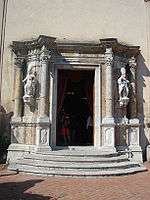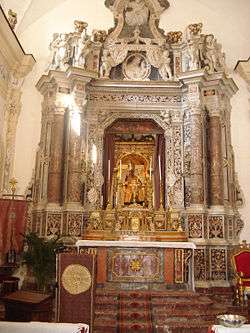Pancras of Taormina
| Saint Pancras of Taormina | |
|---|---|
|
Church of San Pancrazio, Taormina. The altar, which contains a statue of Saint Pancras. | |
| Born | Antiochia in Cilicia |
| Died |
~40 AD Taormina |
| Venerated in | Roman Catholic Church; Eastern Orthodox Church |
| Feast | July 8 or July 9 (formerly April 3); the Eastern Orthodox Church venerates him as a Hieromartyr on July 9 (July 22, N.S.). |
| Attributes | depicted as an old man with yellowing grey hair, vested as a bishop, holding a cross in his right hand, and a Gospel book in his left |
| Patronage | Taormina; Canicattì |
Saint Pancras or Pancratius (Greek: Ἅγιος Παγκράτιος, Hagios Pankratios; Latin: Sanctus Pancratius; Italian: San Pancrazio; Church Slavonic: Свѧтый Панкратїй, Svjatyj Pankratij) is said to have been born in Antioch in Cilicia (the modern Adana).
Legend
According to tradition, he travelled to Jerusalem with his parents during the earthly ministry of Jesus; later the entire family was baptized in Antioch. Pancras withdrew to a cave in Pontus where he was discovered by Saint Peter and was sent to Sicily in the year 40 to be the first Bishop of Tauromenium (the modern Taormina). There he met his death by stoning at the hands of pagan opponents of the new religion.
Veneration
He is venerated as a saint in the Roman Catholic Church and in the Eastern Orthodox Church as a Hieromartyr. In the Catholic Church his cult being concentrated on the island of Sicily, where the veneration of saints from the eastern Mediterranean was particularly encouraged during the period of Byzantine rule. He is the patron saint of Taormina, and Canicattì. His feast day was entered into the Roman Martyrology as April 3; recently this was amended to July 8. More often he is celebrated on July 9, the traditional day of his martyrdom. The larger portion of his relics are preserved at Rome.
The Eastern Orthodox Church venerates him on July 9 (July 22, N.S.). He is also, together with martyrs Marcellus and Philagrus, commemorated on February 9. The Greek calendar also commemorates, on June 7, the holy women Aesia and Susanna, disciples of Pancras and martyred with him. A portion of his relics are kept on Mount Athos.
Saint Pancras of Taormina should not be confused with Saint Pancras of Rome, a young man who was martyred by being beheaded around the year 304.
Depiction in art

In iconography, St Pancras is depicted as an old man with yellowing grey hair, vested as a bishop, holding a cross in his right hand, and a Gospel book in his left. The cross commemorates a miracle attributed to St Pancras whereby he saved the city of Taormina from destruction by the pagan commander Aquilinus. The Gospel represents his preaching of the Christian faith.
See also
References
- Fabio Arduino. "San Pancrazio di Taormina Vescovo e martire" (in Italian). Santi, beati e testimoni.
- Nikolai Velimirovich. "The Prolog of Ohrid: July 9". Serbian Orthodox Church Diocese of Western America.
External links
- Hieromartyr Pancratius the Bishop of Taormina in Sicily Orthodox Icon and Synaxarion
- The Priestly-Martyr Pancratius from The Prologue from Ohrid
- (Italian) San Pancrazio di Taormina
